Trading.com: Identifying and Addressing Business Risks Report
VerifiedAdded on 2023/03/20
|12
|2877
|83
Report
AI Summary
This report analyzes the business risks faced by Trading.com, a start-up offering mentoring and educational webinar services in the stock market. The report identifies risks related to growth, including pressure on employees, aggressive expansion, and inexperience of key staff. It also assesses risks stemming from organizational culture, such as lack of rewards for entrepreneurial risk-taking, executive resistance to bad news, and high internal competition. Furthermore, the report examines information handling risks, including transaction complexity, gaps in diagnostic performance, and a lack of decentralized decision-making. Using the risk exposure calculator, the report provides a total risk score and concludes with recommendations to address these challenges, such as slowing expansion, improving employment standards, fostering a positive organizational culture, and improving information management to ensure the company's sustainability and improved customer service.
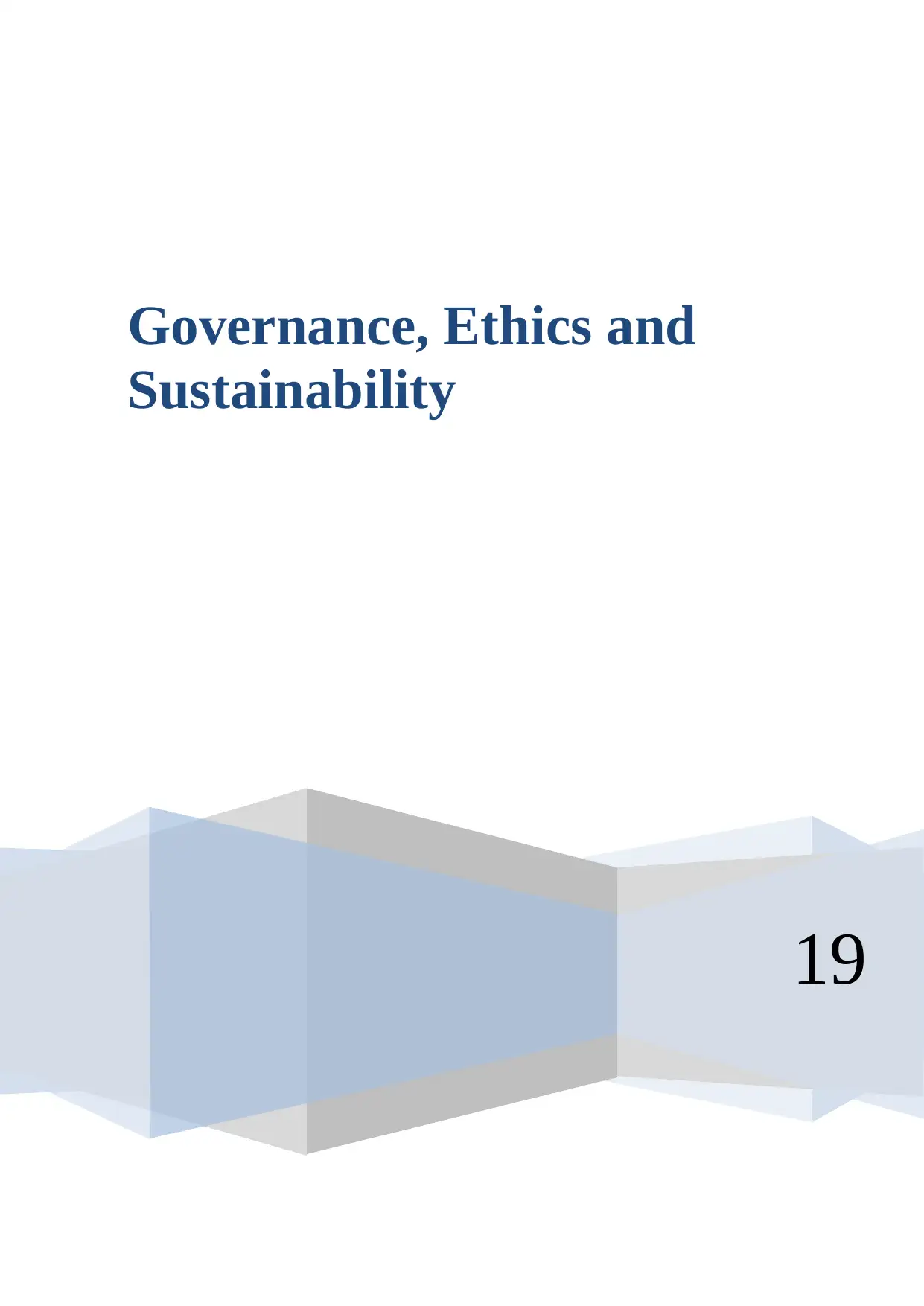
19
Governance, Ethics and
Sustainability
Governance, Ethics and
Sustainability
Paraphrase This Document
Need a fresh take? Get an instant paraphrase of this document with our AI Paraphraser
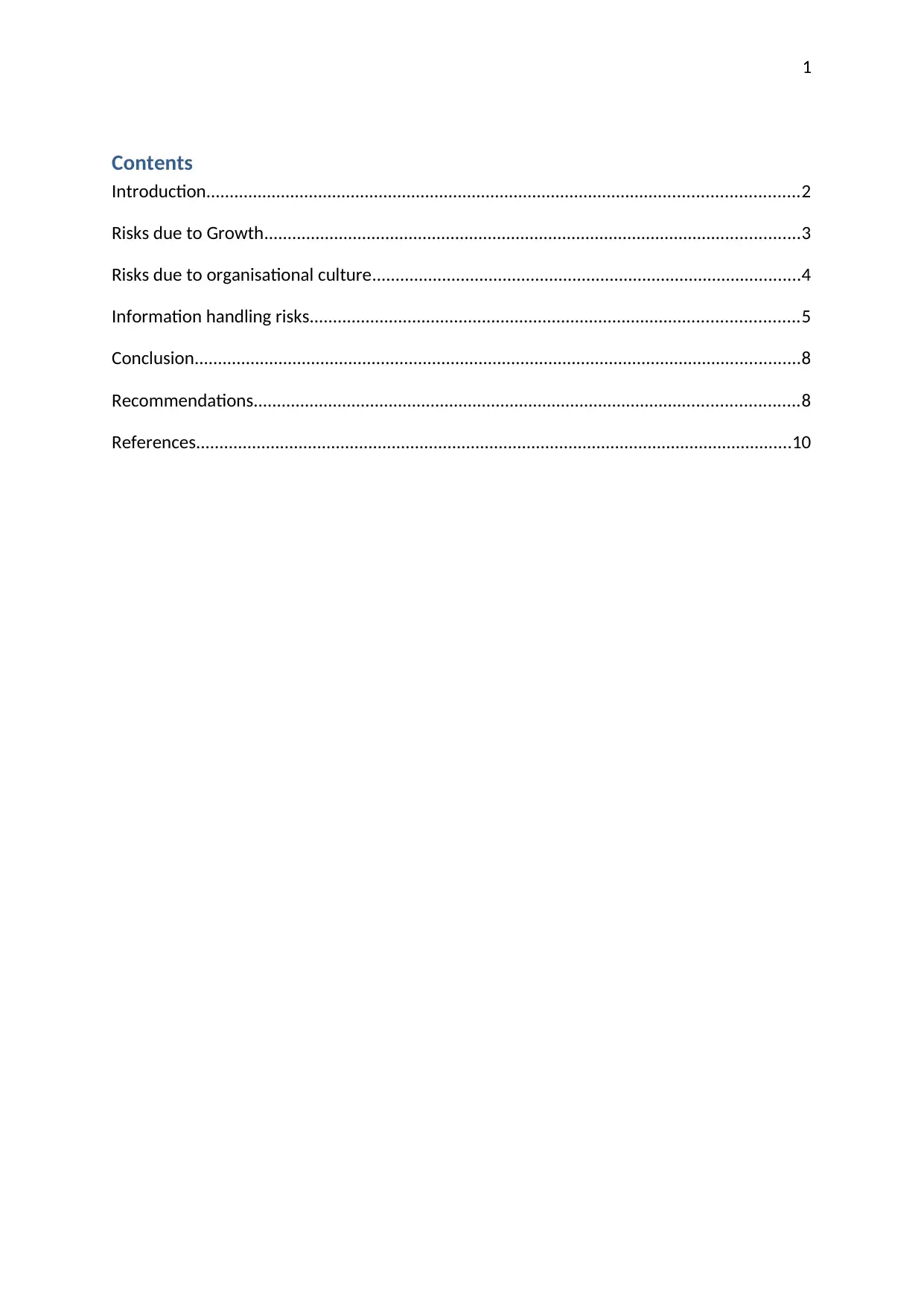
1
Contents
Introduction...............................................................................................................................2
Risks due to Growth...................................................................................................................3
Risks due to organisational culture............................................................................................4
Information handling risks.........................................................................................................5
Conclusion..................................................................................................................................8
Recommendations.....................................................................................................................8
References................................................................................................................................10
Contents
Introduction...............................................................................................................................2
Risks due to Growth...................................................................................................................3
Risks due to organisational culture............................................................................................4
Information handling risks.........................................................................................................5
Conclusion..................................................................................................................................8
Recommendations.....................................................................................................................8
References................................................................................................................................10
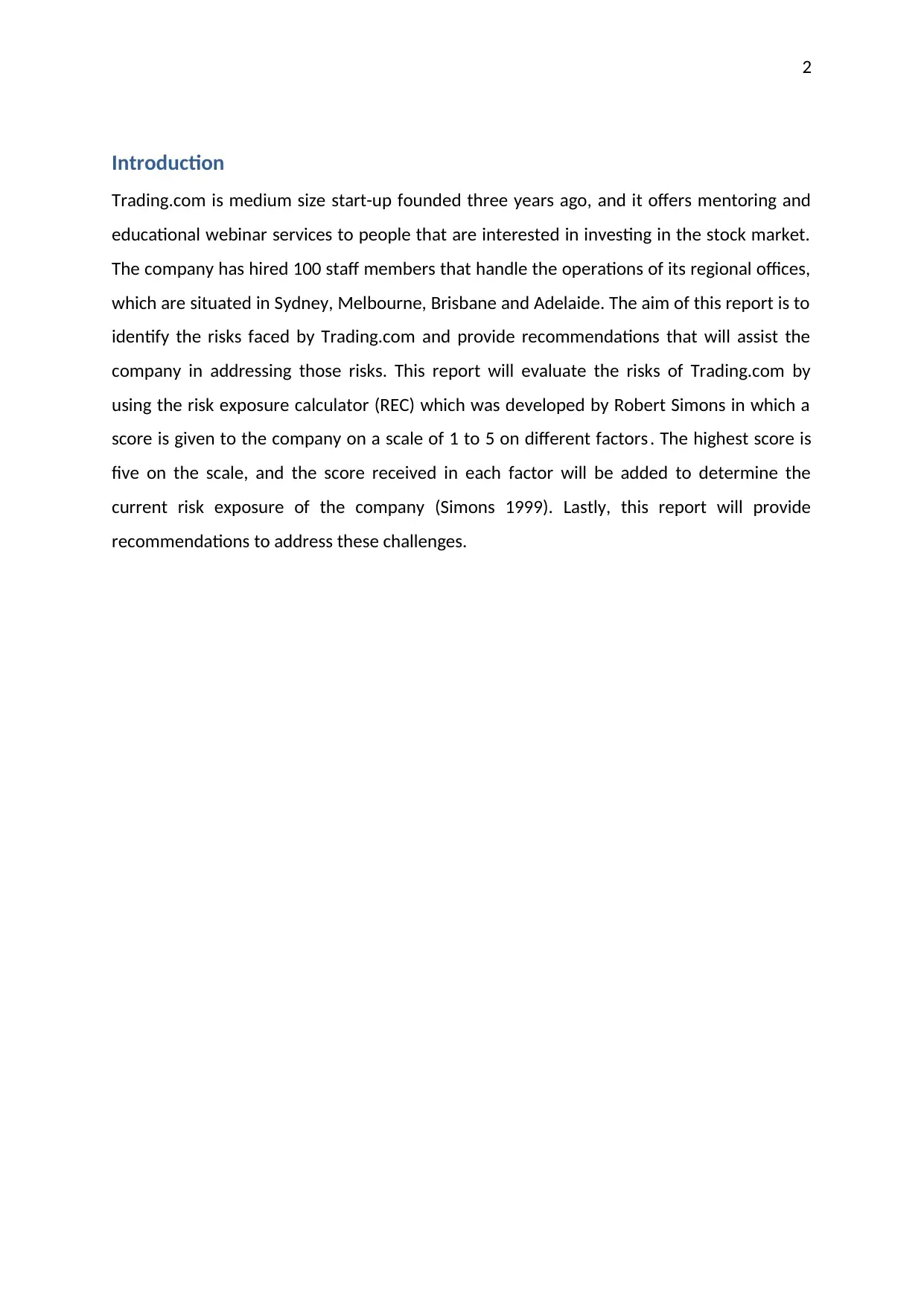
2
Introduction
Trading.com is medium size start-up founded three years ago, and it offers mentoring and
educational webinar services to people that are interested in investing in the stock market.
The company has hired 100 staff members that handle the operations of its regional offices,
which are situated in Sydney, Melbourne, Brisbane and Adelaide. The aim of this report is to
identify the risks faced by Trading.com and provide recommendations that will assist the
company in addressing those risks. This report will evaluate the risks of Trading.com by
using the risk exposure calculator (REC) which was developed by Robert Simons in which a
score is given to the company on a scale of 1 to 5 on different factors . The highest score is
five on the scale, and the score received in each factor will be added to determine the
current risk exposure of the company (Simons 1999). Lastly, this report will provide
recommendations to address these challenges.
Introduction
Trading.com is medium size start-up founded three years ago, and it offers mentoring and
educational webinar services to people that are interested in investing in the stock market.
The company has hired 100 staff members that handle the operations of its regional offices,
which are situated in Sydney, Melbourne, Brisbane and Adelaide. The aim of this report is to
identify the risks faced by Trading.com and provide recommendations that will assist the
company in addressing those risks. This report will evaluate the risks of Trading.com by
using the risk exposure calculator (REC) which was developed by Robert Simons in which a
score is given to the company on a scale of 1 to 5 on different factors . The highest score is
five on the scale, and the score received in each factor will be added to determine the
current risk exposure of the company (Simons 1999). Lastly, this report will provide
recommendations to address these challenges.
⊘ This is a preview!⊘
Do you want full access?
Subscribe today to unlock all pages.

Trusted by 1+ million students worldwide
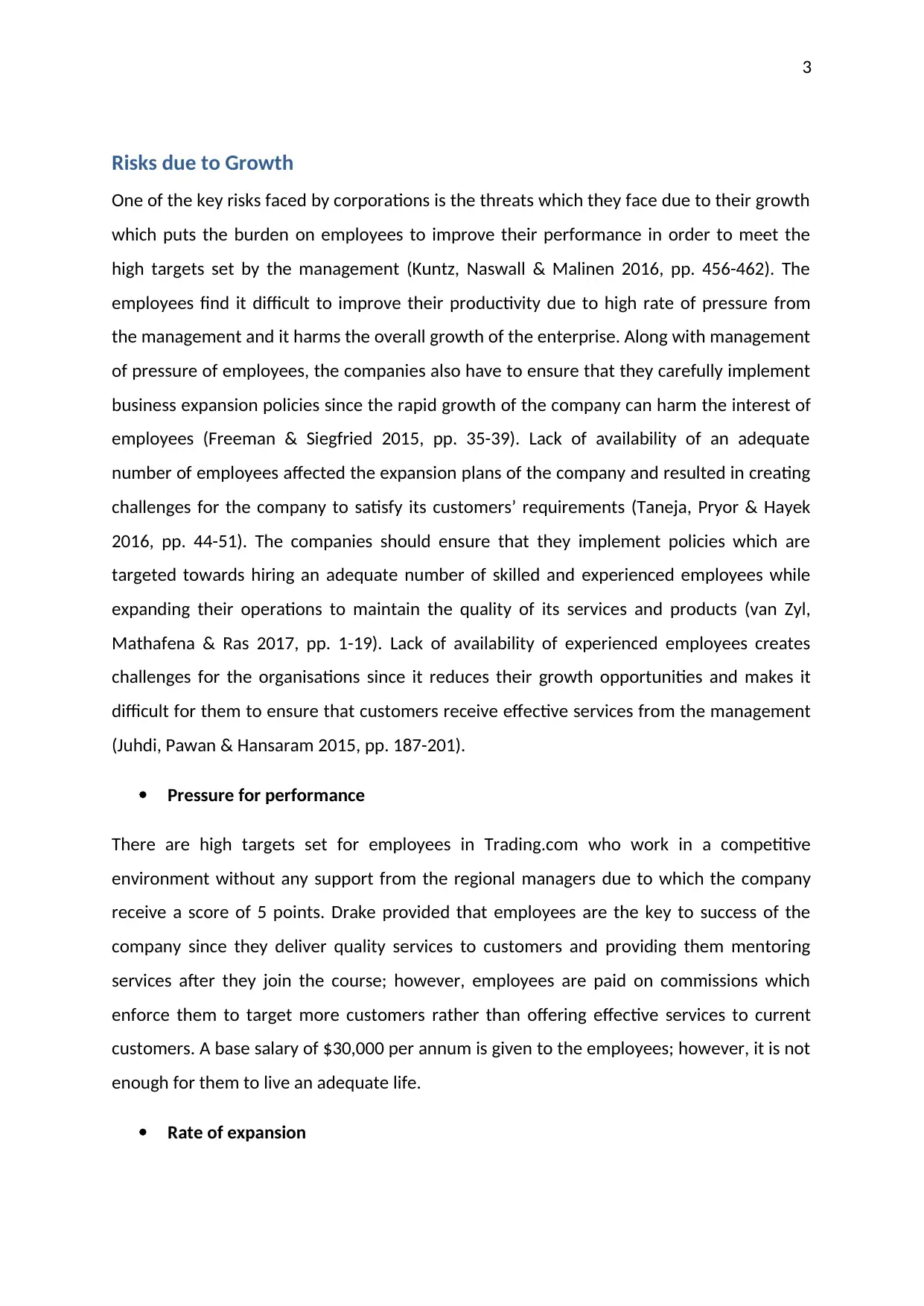
3
Risks due to Growth
One of the key risks faced by corporations is the threats which they face due to their growth
which puts the burden on employees to improve their performance in order to meet the
high targets set by the management (Kuntz, Naswall & Malinen 2016, pp. 456-462). The
employees find it difficult to improve their productivity due to high rate of pressure from
the management and it harms the overall growth of the enterprise. Along with management
of pressure of employees, the companies also have to ensure that they carefully implement
business expansion policies since the rapid growth of the company can harm the interest of
employees (Freeman & Siegfried 2015, pp. 35-39). Lack of availability of an adequate
number of employees affected the expansion plans of the company and resulted in creating
challenges for the company to satisfy its customers’ requirements (Taneja, Pryor & Hayek
2016, pp. 44-51). The companies should ensure that they implement policies which are
targeted towards hiring an adequate number of skilled and experienced employees while
expanding their operations to maintain the quality of its services and products (van Zyl,
Mathafena & Ras 2017, pp. 1-19). Lack of availability of experienced employees creates
challenges for the organisations since it reduces their growth opportunities and makes it
difficult for them to ensure that customers receive effective services from the management
(Juhdi, Pawan & Hansaram 2015, pp. 187-201).
Pressure for performance
There are high targets set for employees in Trading.com who work in a competitive
environment without any support from the regional managers due to which the company
receive a score of 5 points. Drake provided that employees are the key to success of the
company since they deliver quality services to customers and providing them mentoring
services after they join the course; however, employees are paid on commissions which
enforce them to target more customers rather than offering effective services to current
customers. A base salary of $30,000 per annum is given to the employees; however, it is not
enough for them to live an adequate life.
Rate of expansion
Risks due to Growth
One of the key risks faced by corporations is the threats which they face due to their growth
which puts the burden on employees to improve their performance in order to meet the
high targets set by the management (Kuntz, Naswall & Malinen 2016, pp. 456-462). The
employees find it difficult to improve their productivity due to high rate of pressure from
the management and it harms the overall growth of the enterprise. Along with management
of pressure of employees, the companies also have to ensure that they carefully implement
business expansion policies since the rapid growth of the company can harm the interest of
employees (Freeman & Siegfried 2015, pp. 35-39). Lack of availability of an adequate
number of employees affected the expansion plans of the company and resulted in creating
challenges for the company to satisfy its customers’ requirements (Taneja, Pryor & Hayek
2016, pp. 44-51). The companies should ensure that they implement policies which are
targeted towards hiring an adequate number of skilled and experienced employees while
expanding their operations to maintain the quality of its services and products (van Zyl,
Mathafena & Ras 2017, pp. 1-19). Lack of availability of experienced employees creates
challenges for the organisations since it reduces their growth opportunities and makes it
difficult for them to ensure that customers receive effective services from the management
(Juhdi, Pawan & Hansaram 2015, pp. 187-201).
Pressure for performance
There are high targets set for employees in Trading.com who work in a competitive
environment without any support from the regional managers due to which the company
receive a score of 5 points. Drake provided that employees are the key to success of the
company since they deliver quality services to customers and providing them mentoring
services after they join the course; however, employees are paid on commissions which
enforce them to target more customers rather than offering effective services to current
customers. A base salary of $30,000 per annum is given to the employees; however, it is not
enough for them to live an adequate life.
Rate of expansion
Paraphrase This Document
Need a fresh take? Get an instant paraphrase of this document with our AI Paraphraser
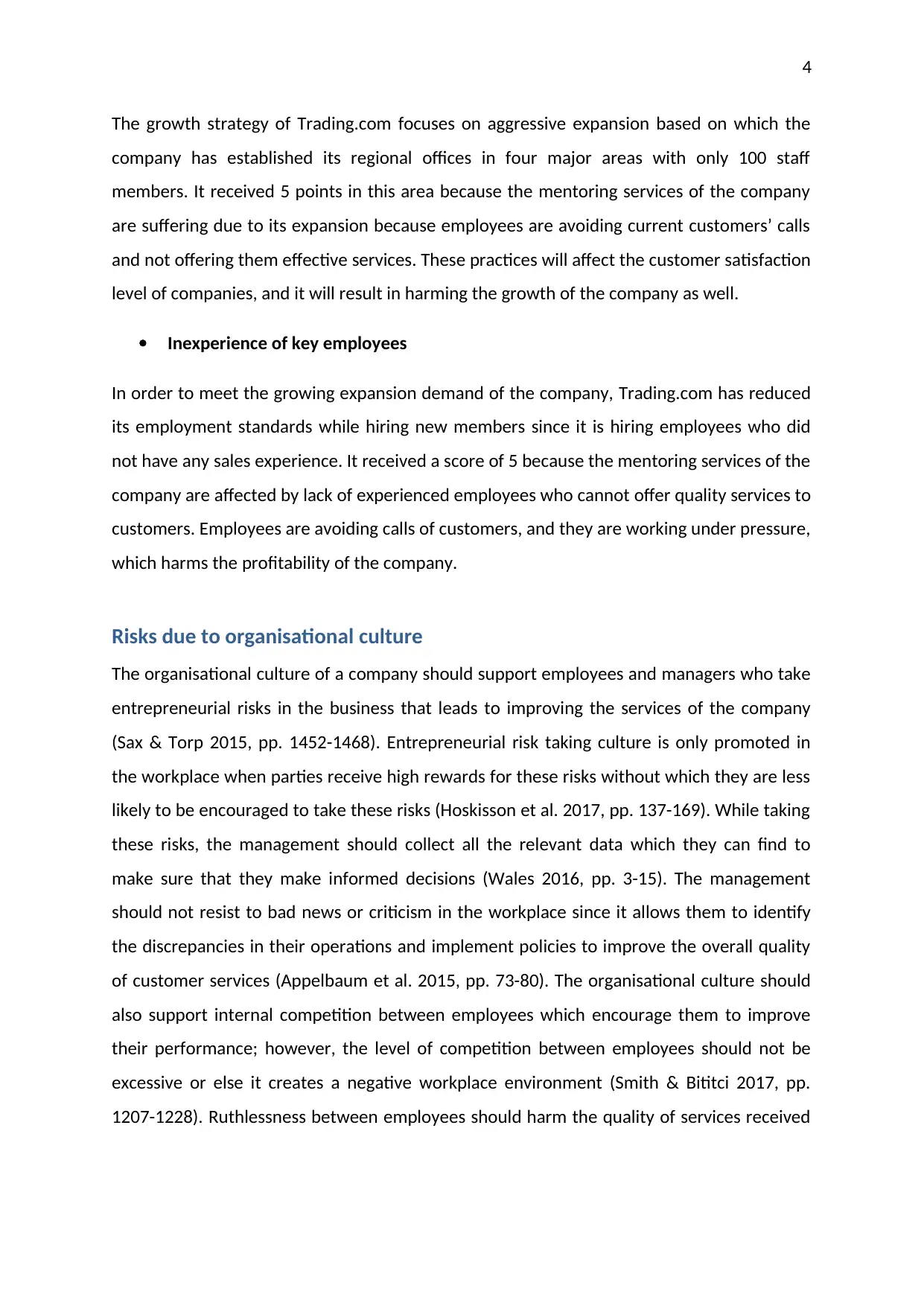
4
The growth strategy of Trading.com focuses on aggressive expansion based on which the
company has established its regional offices in four major areas with only 100 staff
members. It received 5 points in this area because the mentoring services of the company
are suffering due to its expansion because employees are avoiding current customers’ calls
and not offering them effective services. These practices will affect the customer satisfaction
level of companies, and it will result in harming the growth of the company as well.
Inexperience of key employees
In order to meet the growing expansion demand of the company, Trading.com has reduced
its employment standards while hiring new members since it is hiring employees who did
not have any sales experience. It received a score of 5 because the mentoring services of the
company are affected by lack of experienced employees who cannot offer quality services to
customers. Employees are avoiding calls of customers, and they are working under pressure,
which harms the profitability of the company.
Risks due to organisational culture
The organisational culture of a company should support employees and managers who take
entrepreneurial risks in the business that leads to improving the services of the company
(Sax & Torp 2015, pp. 1452-1468). Entrepreneurial risk taking culture is only promoted in
the workplace when parties receive high rewards for these risks without which they are less
likely to be encouraged to take these risks (Hoskisson et al. 2017, pp. 137-169). While taking
these risks, the management should collect all the relevant data which they can find to
make sure that they make informed decisions (Wales 2016, pp. 3-15). The management
should not resist to bad news or criticism in the workplace since it allows them to identify
the discrepancies in their operations and implement policies to improve the overall quality
of customer services (Appelbaum et al. 2015, pp. 73-80). The organisational culture should
also support internal competition between employees which encourage them to improve
their performance; however, the level of competition between employees should not be
excessive or else it creates a negative workplace environment (Smith & Bititci 2017, pp.
1207-1228). Ruthlessness between employees should harm the quality of services received
The growth strategy of Trading.com focuses on aggressive expansion based on which the
company has established its regional offices in four major areas with only 100 staff
members. It received 5 points in this area because the mentoring services of the company
are suffering due to its expansion because employees are avoiding current customers’ calls
and not offering them effective services. These practices will affect the customer satisfaction
level of companies, and it will result in harming the growth of the company as well.
Inexperience of key employees
In order to meet the growing expansion demand of the company, Trading.com has reduced
its employment standards while hiring new members since it is hiring employees who did
not have any sales experience. It received a score of 5 because the mentoring services of the
company are affected by lack of experienced employees who cannot offer quality services to
customers. Employees are avoiding calls of customers, and they are working under pressure,
which harms the profitability of the company.
Risks due to organisational culture
The organisational culture of a company should support employees and managers who take
entrepreneurial risks in the business that leads to improving the services of the company
(Sax & Torp 2015, pp. 1452-1468). Entrepreneurial risk taking culture is only promoted in
the workplace when parties receive high rewards for these risks without which they are less
likely to be encouraged to take these risks (Hoskisson et al. 2017, pp. 137-169). While taking
these risks, the management should collect all the relevant data which they can find to
make sure that they make informed decisions (Wales 2016, pp. 3-15). The management
should not resist to bad news or criticism in the workplace since it allows them to identify
the discrepancies in their operations and implement policies to improve the overall quality
of customer services (Appelbaum et al. 2015, pp. 73-80). The organisational culture should
also support internal competition between employees which encourage them to improve
their performance; however, the level of competition between employees should not be
excessive or else it creates a negative workplace environment (Smith & Bititci 2017, pp.
1207-1228). Ruthlessness between employees should harm the quality of services received
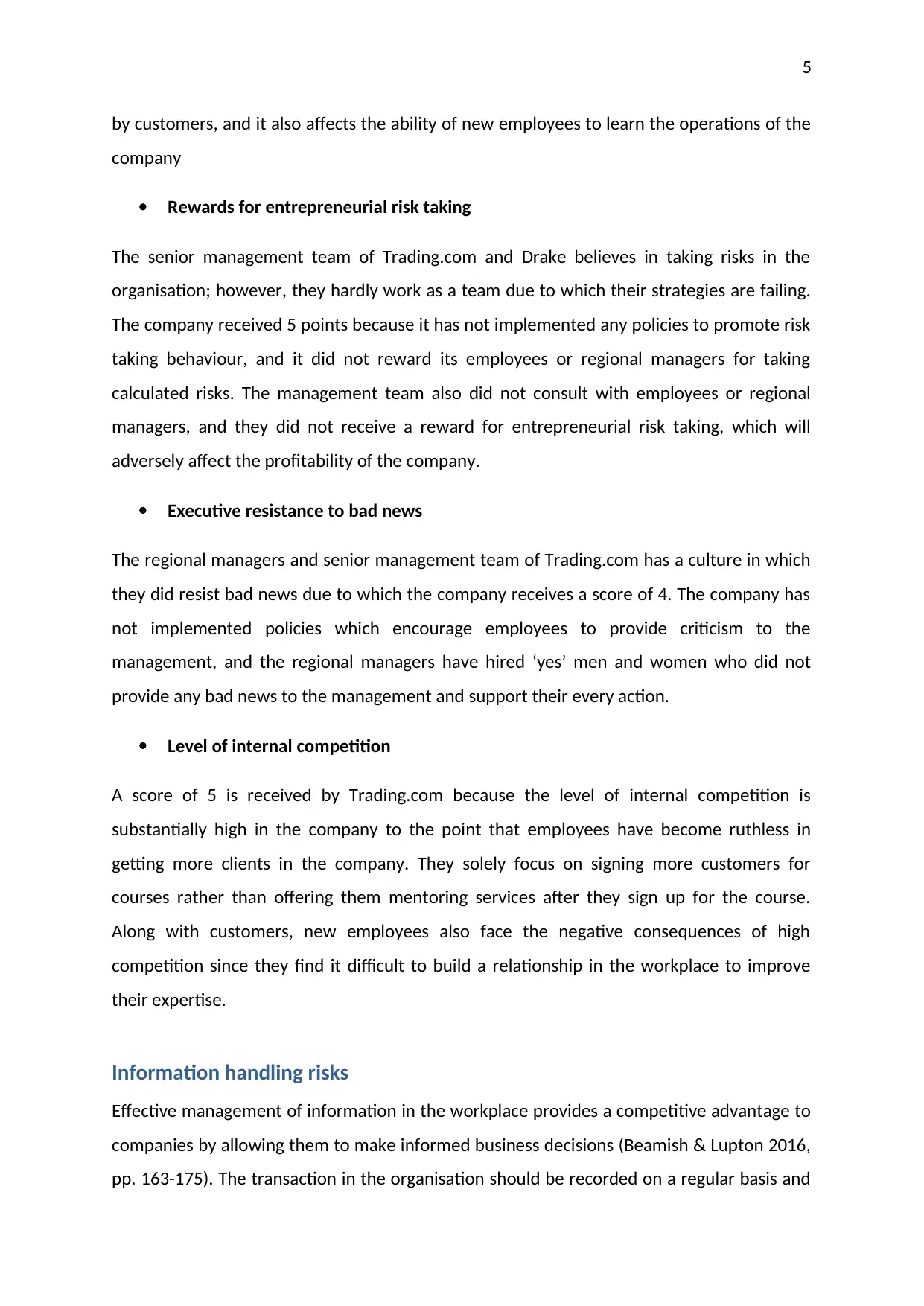
5
by customers, and it also affects the ability of new employees to learn the operations of the
company
Rewards for entrepreneurial risk taking
The senior management team of Trading.com and Drake believes in taking risks in the
organisation; however, they hardly work as a team due to which their strategies are failing.
The company received 5 points because it has not implemented any policies to promote risk
taking behaviour, and it did not reward its employees or regional managers for taking
calculated risks. The management team also did not consult with employees or regional
managers, and they did not receive a reward for entrepreneurial risk taking, which will
adversely affect the profitability of the company.
Executive resistance to bad news
The regional managers and senior management team of Trading.com has a culture in which
they did resist bad news due to which the company receives a score of 4. The company has
not implemented policies which encourage employees to provide criticism to the
management, and the regional managers have hired ‘yes’ men and women who did not
provide any bad news to the management and support their every action.
Level of internal competition
A score of 5 is received by Trading.com because the level of internal competition is
substantially high in the company to the point that employees have become ruthless in
getting more clients in the company. They solely focus on signing more customers for
courses rather than offering them mentoring services after they sign up for the course.
Along with customers, new employees also face the negative consequences of high
competition since they find it difficult to build a relationship in the workplace to improve
their expertise.
Information handling risks
Effective management of information in the workplace provides a competitive advantage to
companies by allowing them to make informed business decisions (Beamish & Lupton 2016,
pp. 163-175). The transaction in the organisation should be recorded on a regular basis and
by customers, and it also affects the ability of new employees to learn the operations of the
company
Rewards for entrepreneurial risk taking
The senior management team of Trading.com and Drake believes in taking risks in the
organisation; however, they hardly work as a team due to which their strategies are failing.
The company received 5 points because it has not implemented any policies to promote risk
taking behaviour, and it did not reward its employees or regional managers for taking
calculated risks. The management team also did not consult with employees or regional
managers, and they did not receive a reward for entrepreneurial risk taking, which will
adversely affect the profitability of the company.
Executive resistance to bad news
The regional managers and senior management team of Trading.com has a culture in which
they did resist bad news due to which the company receives a score of 4. The company has
not implemented policies which encourage employees to provide criticism to the
management, and the regional managers have hired ‘yes’ men and women who did not
provide any bad news to the management and support their every action.
Level of internal competition
A score of 5 is received by Trading.com because the level of internal competition is
substantially high in the company to the point that employees have become ruthless in
getting more clients in the company. They solely focus on signing more customers for
courses rather than offering them mentoring services after they sign up for the course.
Along with customers, new employees also face the negative consequences of high
competition since they find it difficult to build a relationship in the workplace to improve
their expertise.
Information handling risks
Effective management of information in the workplace provides a competitive advantage to
companies by allowing them to make informed business decisions (Beamish & Lupton 2016,
pp. 163-175). The transaction in the organisation should be recorded on a regular basis and
⊘ This is a preview!⊘
Do you want full access?
Subscribe today to unlock all pages.

Trusted by 1+ million students worldwide
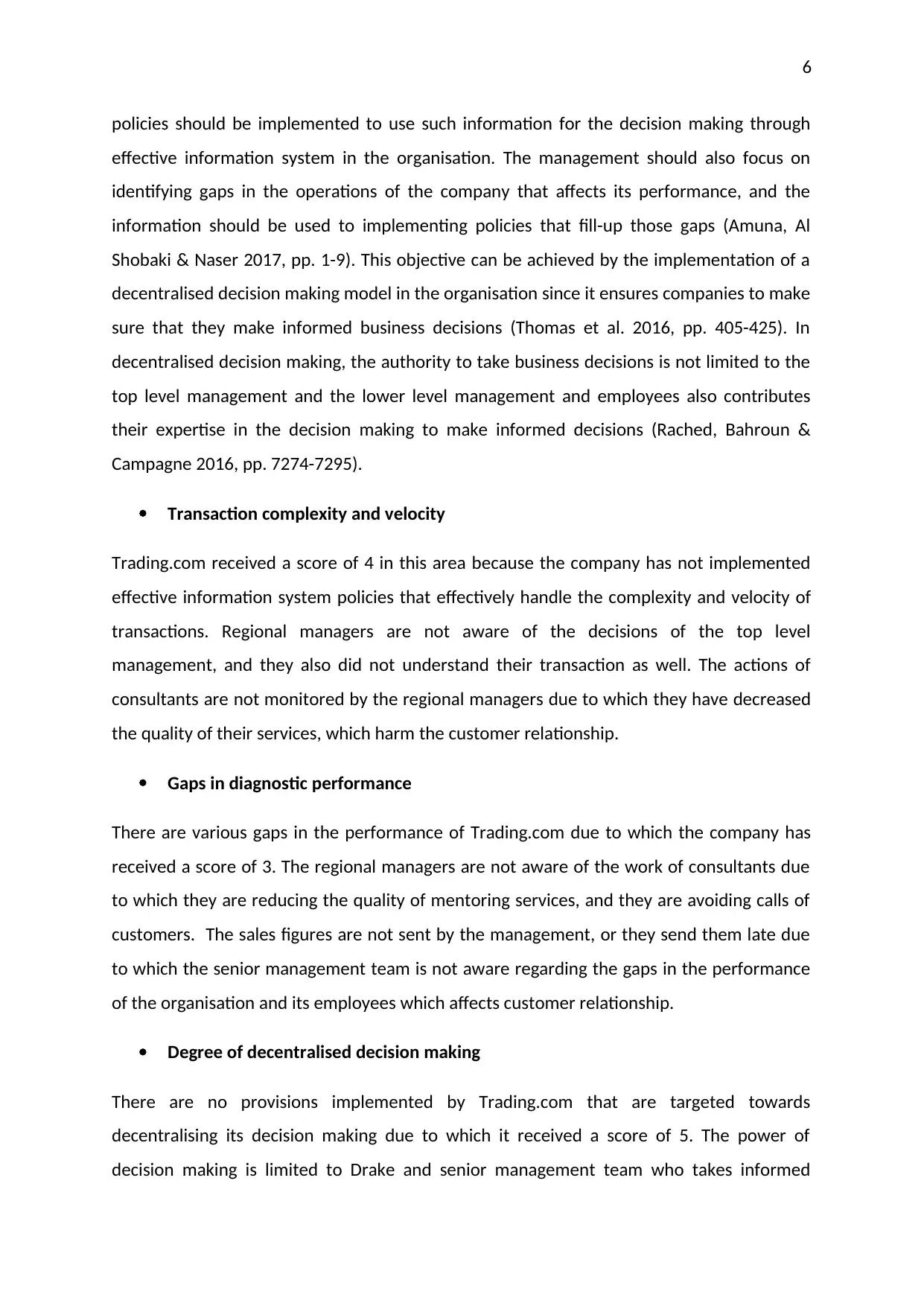
6
policies should be implemented to use such information for the decision making through
effective information system in the organisation. The management should also focus on
identifying gaps in the operations of the company that affects its performance, and the
information should be used to implementing policies that fill-up those gaps (Amuna, Al
Shobaki & Naser 2017, pp. 1-9). This objective can be achieved by the implementation of a
decentralised decision making model in the organisation since it ensures companies to make
sure that they make informed business decisions (Thomas et al. 2016, pp. 405-425). In
decentralised decision making, the authority to take business decisions is not limited to the
top level management and the lower level management and employees also contributes
their expertise in the decision making to make informed decisions (Rached, Bahroun &
Campagne 2016, pp. 7274-7295).
Transaction complexity and velocity
Trading.com received a score of 4 in this area because the company has not implemented
effective information system policies that effectively handle the complexity and velocity of
transactions. Regional managers are not aware of the decisions of the top level
management, and they also did not understand their transaction as well. The actions of
consultants are not monitored by the regional managers due to which they have decreased
the quality of their services, which harm the customer relationship.
Gaps in diagnostic performance
There are various gaps in the performance of Trading.com due to which the company has
received a score of 3. The regional managers are not aware of the work of consultants due
to which they are reducing the quality of mentoring services, and they are avoiding calls of
customers. The sales figures are not sent by the management, or they send them late due
to which the senior management team is not aware regarding the gaps in the performance
of the organisation and its employees which affects customer relationship.
Degree of decentralised decision making
There are no provisions implemented by Trading.com that are targeted towards
decentralising its decision making due to which it received a score of 5. The power of
decision making is limited to Drake and senior management team who takes informed
policies should be implemented to use such information for the decision making through
effective information system in the organisation. The management should also focus on
identifying gaps in the operations of the company that affects its performance, and the
information should be used to implementing policies that fill-up those gaps (Amuna, Al
Shobaki & Naser 2017, pp. 1-9). This objective can be achieved by the implementation of a
decentralised decision making model in the organisation since it ensures companies to make
sure that they make informed business decisions (Thomas et al. 2016, pp. 405-425). In
decentralised decision making, the authority to take business decisions is not limited to the
top level management and the lower level management and employees also contributes
their expertise in the decision making to make informed decisions (Rached, Bahroun &
Campagne 2016, pp. 7274-7295).
Transaction complexity and velocity
Trading.com received a score of 4 in this area because the company has not implemented
effective information system policies that effectively handle the complexity and velocity of
transactions. Regional managers are not aware of the decisions of the top level
management, and they also did not understand their transaction as well. The actions of
consultants are not monitored by the regional managers due to which they have decreased
the quality of their services, which harm the customer relationship.
Gaps in diagnostic performance
There are various gaps in the performance of Trading.com due to which the company has
received a score of 3. The regional managers are not aware of the work of consultants due
to which they are reducing the quality of mentoring services, and they are avoiding calls of
customers. The sales figures are not sent by the management, or they send them late due
to which the senior management team is not aware regarding the gaps in the performance
of the organisation and its employees which affects customer relationship.
Degree of decentralised decision making
There are no provisions implemented by Trading.com that are targeted towards
decentralising its decision making due to which it received a score of 5. The power of
decision making is limited to Drake and senior management team who takes informed
Paraphrase This Document
Need a fresh take? Get an instant paraphrase of this document with our AI Paraphraser
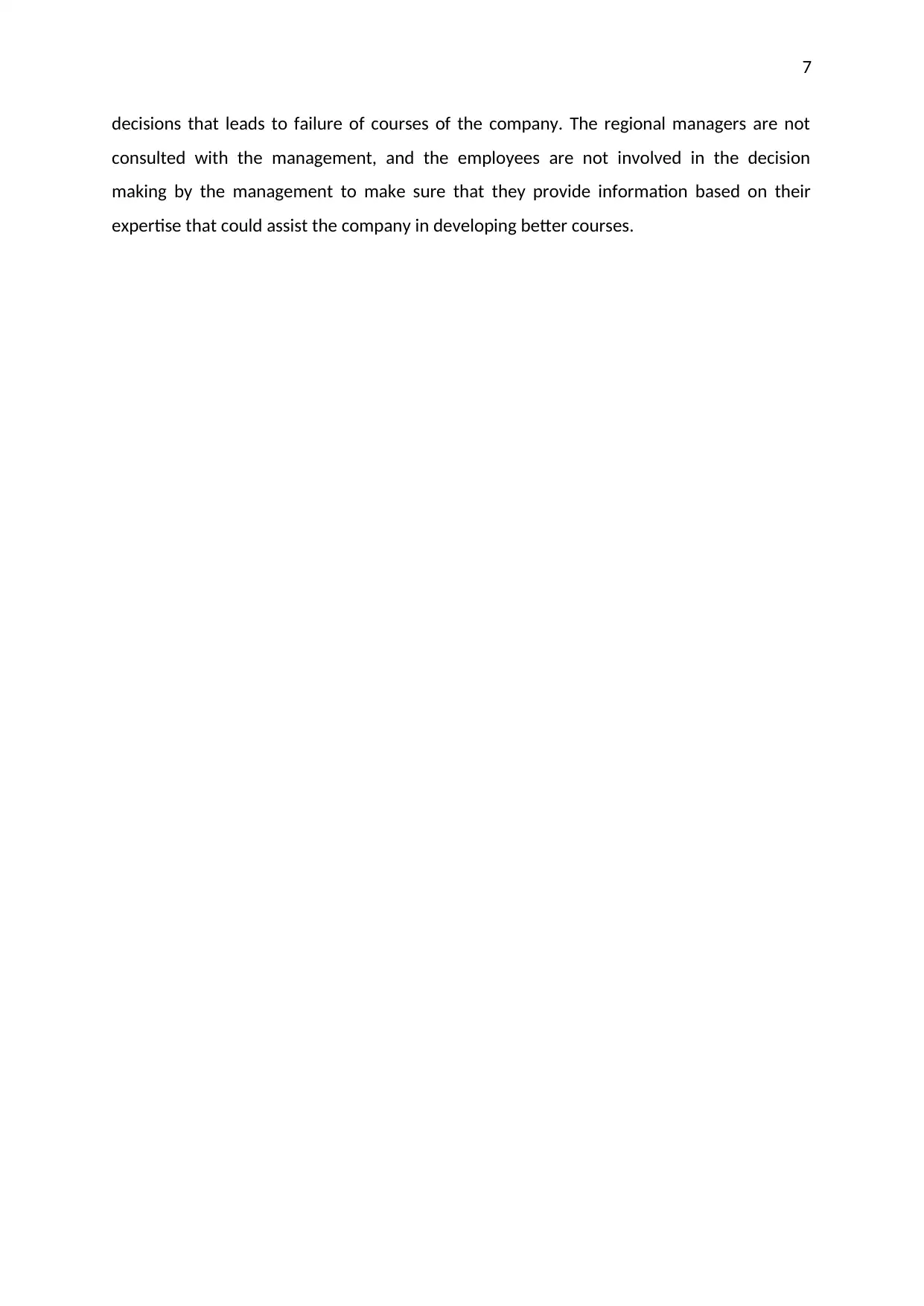
7
decisions that leads to failure of courses of the company. The regional managers are not
consulted with the management, and the employees are not involved in the decision
making by the management to make sure that they provide information based on their
expertise that could assist the company in developing better courses.
decisions that leads to failure of courses of the company. The regional managers are not
consulted with the management, and the employees are not involved in the decision
making by the management to make sure that they provide information based on their
expertise that could assist the company in developing better courses.
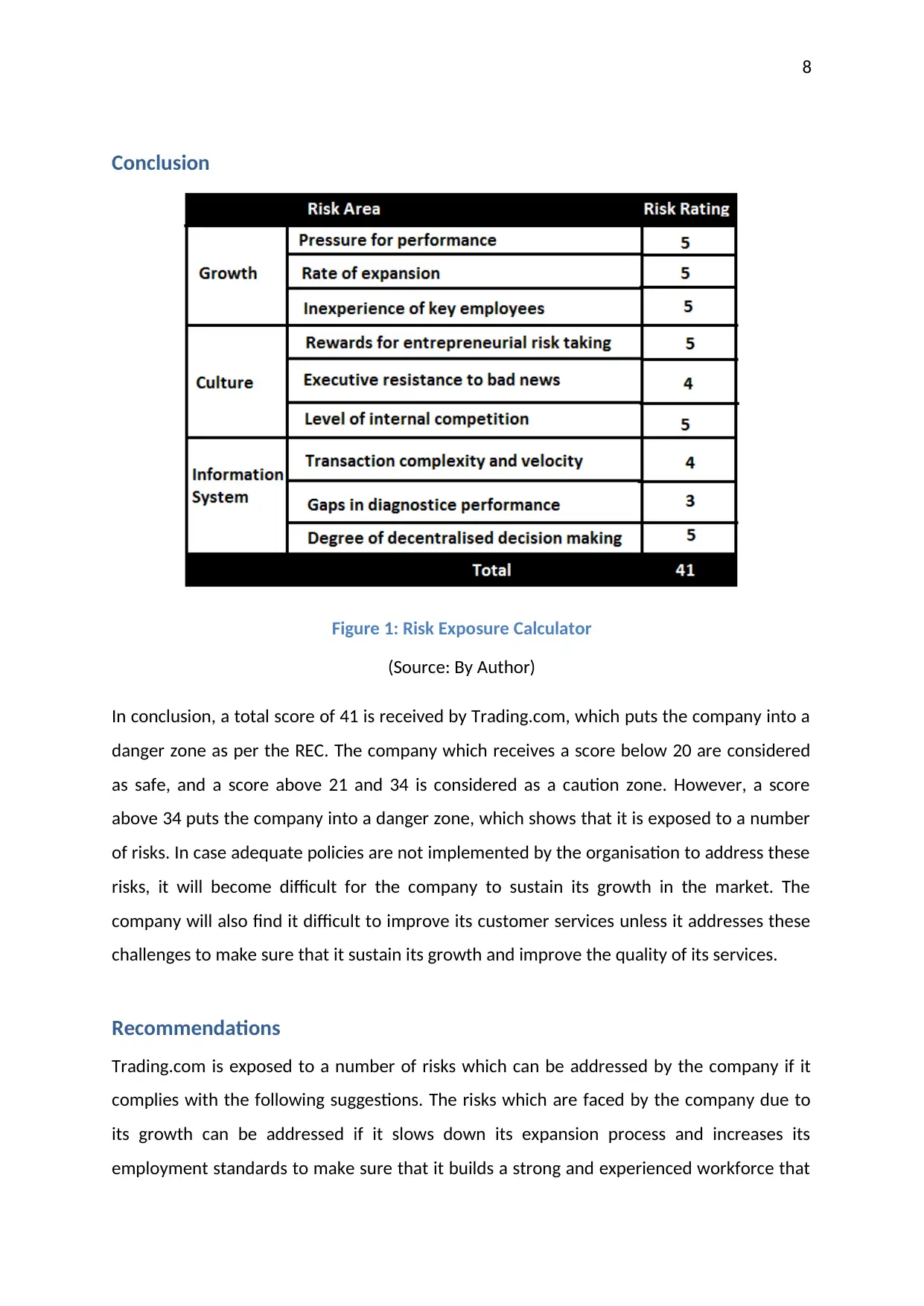
8
Conclusion
Figure 1: Risk Exposure Calculator
(Source: By Author)
In conclusion, a total score of 41 is received by Trading.com, which puts the company into a
danger zone as per the REC. The company which receives a score below 20 are considered
as safe, and a score above 21 and 34 is considered as a caution zone. However, a score
above 34 puts the company into a danger zone, which shows that it is exposed to a number
of risks. In case adequate policies are not implemented by the organisation to address these
risks, it will become difficult for the company to sustain its growth in the market. The
company will also find it difficult to improve its customer services unless it addresses these
challenges to make sure that it sustain its growth and improve the quality of its services.
Recommendations
Trading.com is exposed to a number of risks which can be addressed by the company if it
complies with the following suggestions. The risks which are faced by the company due to
its growth can be addressed if it slows down its expansion process and increases its
employment standards to make sure that it builds a strong and experienced workforce that
Conclusion
Figure 1: Risk Exposure Calculator
(Source: By Author)
In conclusion, a total score of 41 is received by Trading.com, which puts the company into a
danger zone as per the REC. The company which receives a score below 20 are considered
as safe, and a score above 21 and 34 is considered as a caution zone. However, a score
above 34 puts the company into a danger zone, which shows that it is exposed to a number
of risks. In case adequate policies are not implemented by the organisation to address these
risks, it will become difficult for the company to sustain its growth in the market. The
company will also find it difficult to improve its customer services unless it addresses these
challenges to make sure that it sustain its growth and improve the quality of its services.
Recommendations
Trading.com is exposed to a number of risks which can be addressed by the company if it
complies with the following suggestions. The risks which are faced by the company due to
its growth can be addressed if it slows down its expansion process and increases its
employment standards to make sure that it builds a strong and experienced workforce that
⊘ This is a preview!⊘
Do you want full access?
Subscribe today to unlock all pages.

Trusted by 1+ million students worldwide
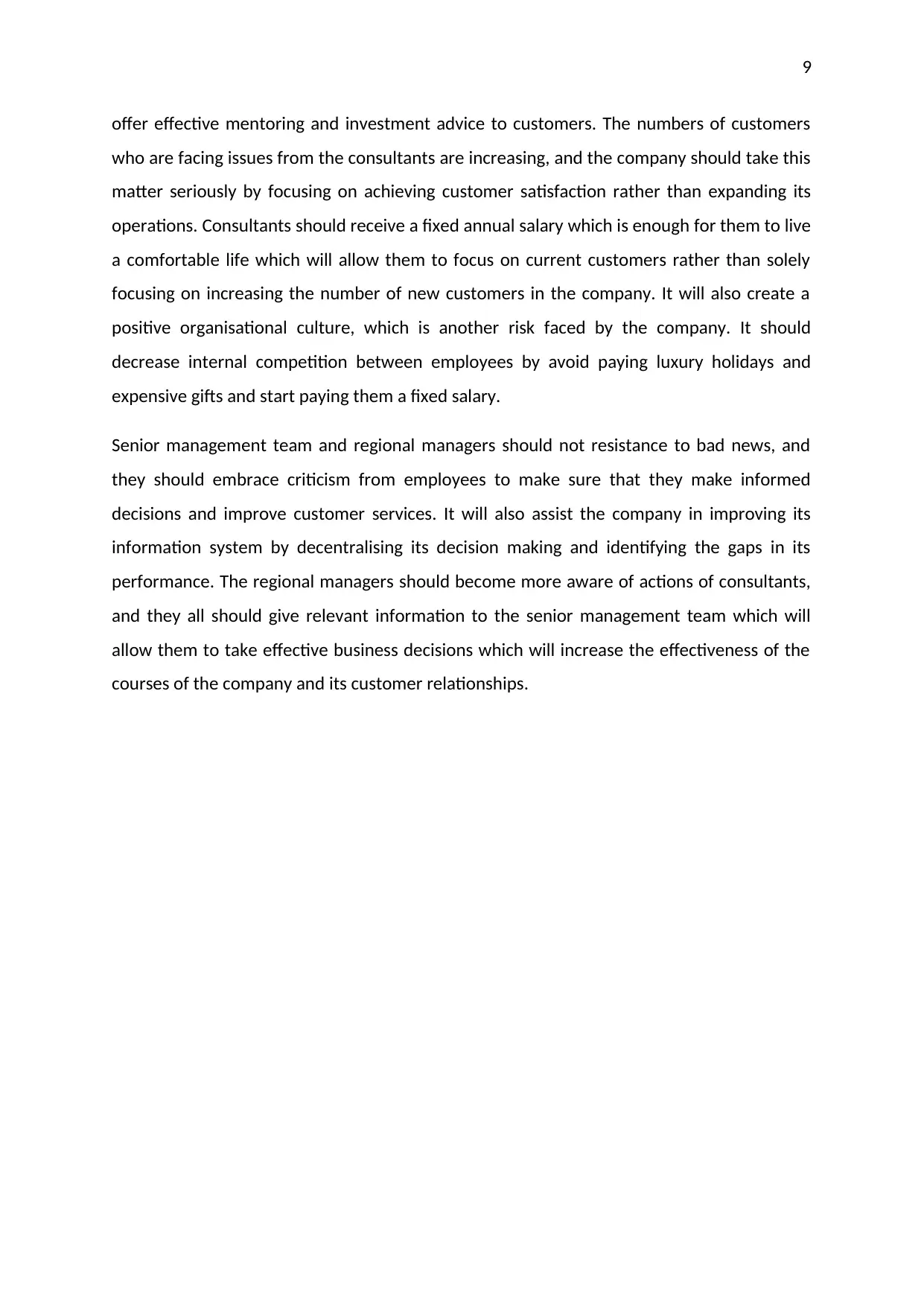
9
offer effective mentoring and investment advice to customers. The numbers of customers
who are facing issues from the consultants are increasing, and the company should take this
matter seriously by focusing on achieving customer satisfaction rather than expanding its
operations. Consultants should receive a fixed annual salary which is enough for them to live
a comfortable life which will allow them to focus on current customers rather than solely
focusing on increasing the number of new customers in the company. It will also create a
positive organisational culture, which is another risk faced by the company. It should
decrease internal competition between employees by avoid paying luxury holidays and
expensive gifts and start paying them a fixed salary.
Senior management team and regional managers should not resistance to bad news, and
they should embrace criticism from employees to make sure that they make informed
decisions and improve customer services. It will also assist the company in improving its
information system by decentralising its decision making and identifying the gaps in its
performance. The regional managers should become more aware of actions of consultants,
and they all should give relevant information to the senior management team which will
allow them to take effective business decisions which will increase the effectiveness of the
courses of the company and its customer relationships.
offer effective mentoring and investment advice to customers. The numbers of customers
who are facing issues from the consultants are increasing, and the company should take this
matter seriously by focusing on achieving customer satisfaction rather than expanding its
operations. Consultants should receive a fixed annual salary which is enough for them to live
a comfortable life which will allow them to focus on current customers rather than solely
focusing on increasing the number of new customers in the company. It will also create a
positive organisational culture, which is another risk faced by the company. It should
decrease internal competition between employees by avoid paying luxury holidays and
expensive gifts and start paying them a fixed salary.
Senior management team and regional managers should not resistance to bad news, and
they should embrace criticism from employees to make sure that they make informed
decisions and improve customer services. It will also assist the company in improving its
information system by decentralising its decision making and identifying the gaps in its
performance. The regional managers should become more aware of actions of consultants,
and they all should give relevant information to the senior management team which will
allow them to take effective business decisions which will increase the effectiveness of the
courses of the company and its customer relationships.
Paraphrase This Document
Need a fresh take? Get an instant paraphrase of this document with our AI Paraphraser
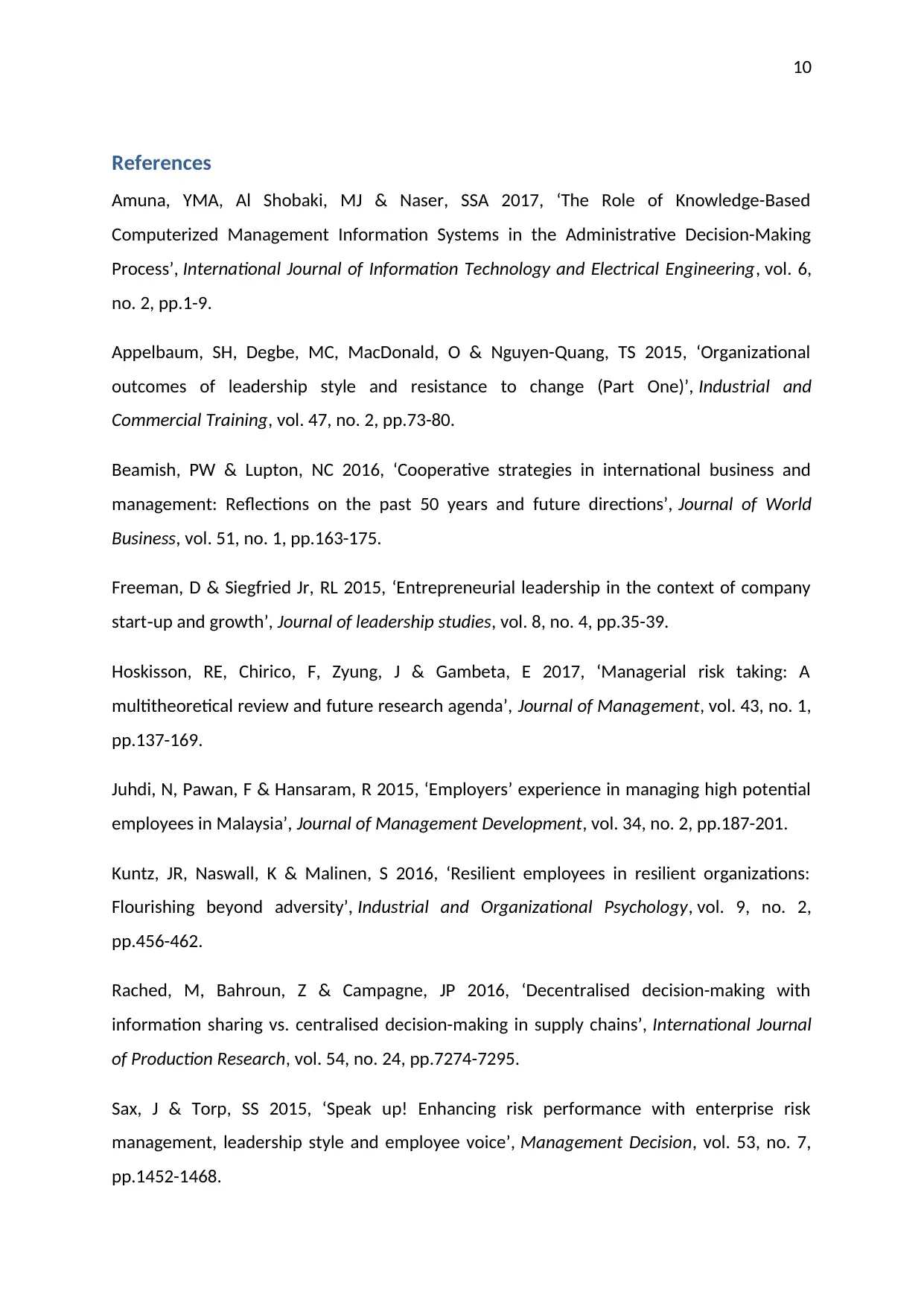
10
References
Amuna, YMA, Al Shobaki, MJ & Naser, SSA 2017, ‘The Role of Knowledge-Based
Computerized Management Information Systems in the Administrative Decision-Making
Process’, International Journal of Information Technology and Electrical Engineering, vol. 6,
no. 2, pp.1-9.
Appelbaum, SH, Degbe, MC, MacDonald, O & Nguyen-Quang, TS 2015, ‘Organizational
outcomes of leadership style and resistance to change (Part One)’, Industrial and
Commercial Training, vol. 47, no. 2, pp.73-80.
Beamish, PW & Lupton, NC 2016, ‘Cooperative strategies in international business and
management: Reflections on the past 50 years and future directions’, Journal of World
Business, vol. 51, no. 1, pp.163-175.
Freeman, D & Siegfried Jr, RL 2015, ‘Entrepreneurial leadership in the context of company
start‐up and growth’, Journal of leadership studies, vol. 8, no. 4, pp.35-39.
Hoskisson, RE, Chirico, F, Zyung, J & Gambeta, E 2017, ‘Managerial risk taking: A
multitheoretical review and future research agenda’, Journal of Management, vol. 43, no. 1,
pp.137-169.
Juhdi, N, Pawan, F & Hansaram, R 2015, ‘Employers’ experience in managing high potential
employees in Malaysia’, Journal of Management Development, vol. 34, no. 2, pp.187-201.
Kuntz, JR, Naswall, K & Malinen, S 2016, ‘Resilient employees in resilient organizations:
Flourishing beyond adversity’, Industrial and Organizational Psychology, vol. 9, no. 2,
pp.456-462.
Rached, M, Bahroun, Z & Campagne, JP 2016, ‘Decentralised decision-making with
information sharing vs. centralised decision-making in supply chains’, International Journal
of Production Research, vol. 54, no. 24, pp.7274-7295.
Sax, J & Torp, SS 2015, ‘Speak up! Enhancing risk performance with enterprise risk
management, leadership style and employee voice’, Management Decision, vol. 53, no. 7,
pp.1452-1468.
References
Amuna, YMA, Al Shobaki, MJ & Naser, SSA 2017, ‘The Role of Knowledge-Based
Computerized Management Information Systems in the Administrative Decision-Making
Process’, International Journal of Information Technology and Electrical Engineering, vol. 6,
no. 2, pp.1-9.
Appelbaum, SH, Degbe, MC, MacDonald, O & Nguyen-Quang, TS 2015, ‘Organizational
outcomes of leadership style and resistance to change (Part One)’, Industrial and
Commercial Training, vol. 47, no. 2, pp.73-80.
Beamish, PW & Lupton, NC 2016, ‘Cooperative strategies in international business and
management: Reflections on the past 50 years and future directions’, Journal of World
Business, vol. 51, no. 1, pp.163-175.
Freeman, D & Siegfried Jr, RL 2015, ‘Entrepreneurial leadership in the context of company
start‐up and growth’, Journal of leadership studies, vol. 8, no. 4, pp.35-39.
Hoskisson, RE, Chirico, F, Zyung, J & Gambeta, E 2017, ‘Managerial risk taking: A
multitheoretical review and future research agenda’, Journal of Management, vol. 43, no. 1,
pp.137-169.
Juhdi, N, Pawan, F & Hansaram, R 2015, ‘Employers’ experience in managing high potential
employees in Malaysia’, Journal of Management Development, vol. 34, no. 2, pp.187-201.
Kuntz, JR, Naswall, K & Malinen, S 2016, ‘Resilient employees in resilient organizations:
Flourishing beyond adversity’, Industrial and Organizational Psychology, vol. 9, no. 2,
pp.456-462.
Rached, M, Bahroun, Z & Campagne, JP 2016, ‘Decentralised decision-making with
information sharing vs. centralised decision-making in supply chains’, International Journal
of Production Research, vol. 54, no. 24, pp.7274-7295.
Sax, J & Torp, SS 2015, ‘Speak up! Enhancing risk performance with enterprise risk
management, leadership style and employee voice’, Management Decision, vol. 53, no. 7,
pp.1452-1468.
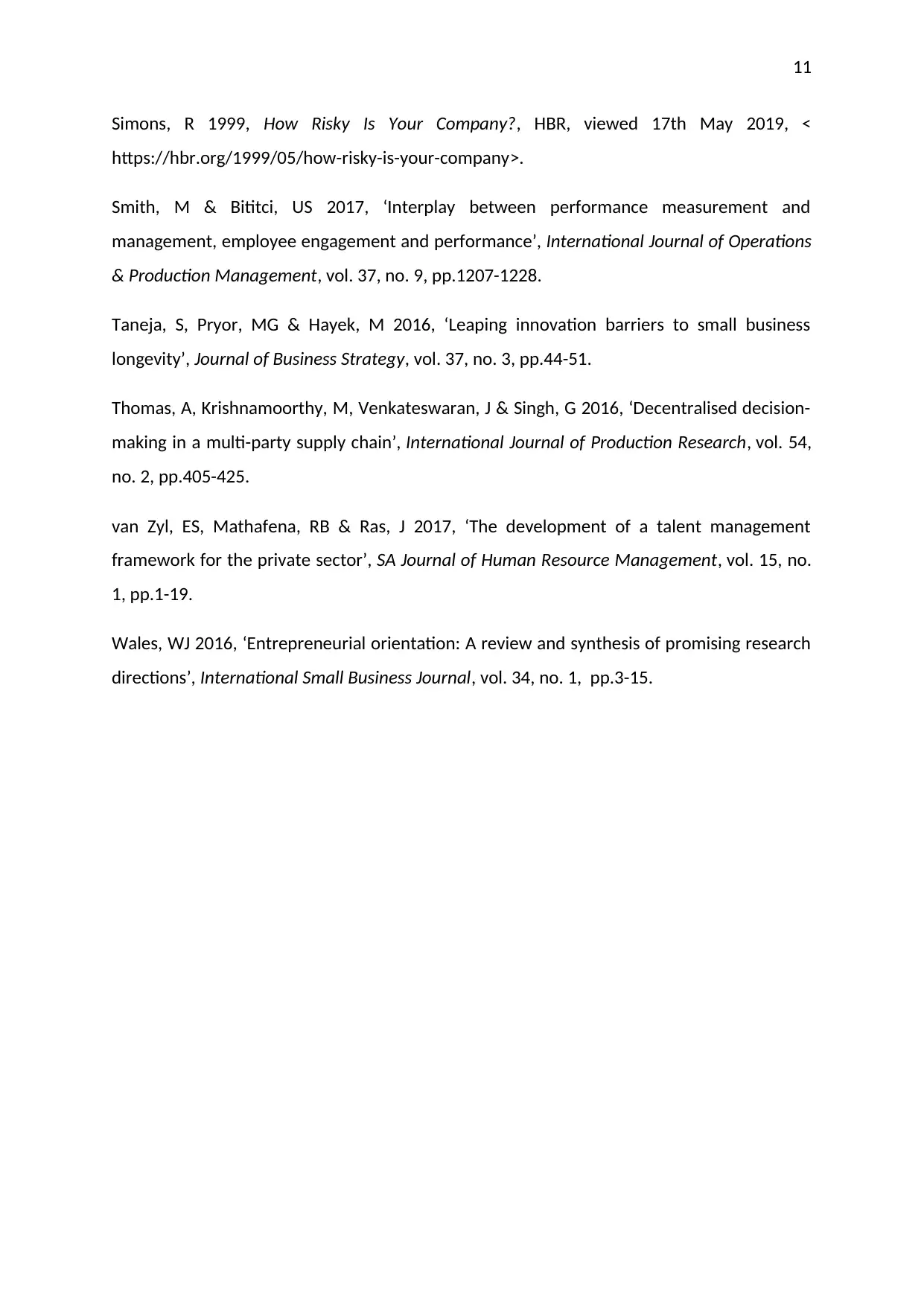
11
Simons, R 1999, How Risky Is Your Company?, HBR, viewed 17th May 2019, <
https://hbr.org/1999/05/how-risky-is-your-company>.
Smith, M & Bititci, US 2017, ‘Interplay between performance measurement and
management, employee engagement and performance’, International Journal of Operations
& Production Management, vol. 37, no. 9, pp.1207-1228.
Taneja, S, Pryor, MG & Hayek, M 2016, ‘Leaping innovation barriers to small business
longevity’, Journal of Business Strategy, vol. 37, no. 3, pp.44-51.
Thomas, A, Krishnamoorthy, M, Venkateswaran, J & Singh, G 2016, ‘Decentralised decision-
making in a multi-party supply chain’, International Journal of Production Research, vol. 54,
no. 2, pp.405-425.
van Zyl, ES, Mathafena, RB & Ras, J 2017, ‘The development of a talent management
framework for the private sector’, SA Journal of Human Resource Management, vol. 15, no.
1, pp.1-19.
Wales, WJ 2016, ‘Entrepreneurial orientation: A review and synthesis of promising research
directions’, International Small Business Journal, vol. 34, no. 1, pp.3-15.
Simons, R 1999, How Risky Is Your Company?, HBR, viewed 17th May 2019, <
https://hbr.org/1999/05/how-risky-is-your-company>.
Smith, M & Bititci, US 2017, ‘Interplay between performance measurement and
management, employee engagement and performance’, International Journal of Operations
& Production Management, vol. 37, no. 9, pp.1207-1228.
Taneja, S, Pryor, MG & Hayek, M 2016, ‘Leaping innovation barriers to small business
longevity’, Journal of Business Strategy, vol. 37, no. 3, pp.44-51.
Thomas, A, Krishnamoorthy, M, Venkateswaran, J & Singh, G 2016, ‘Decentralised decision-
making in a multi-party supply chain’, International Journal of Production Research, vol. 54,
no. 2, pp.405-425.
van Zyl, ES, Mathafena, RB & Ras, J 2017, ‘The development of a talent management
framework for the private sector’, SA Journal of Human Resource Management, vol. 15, no.
1, pp.1-19.
Wales, WJ 2016, ‘Entrepreneurial orientation: A review and synthesis of promising research
directions’, International Small Business Journal, vol. 34, no. 1, pp.3-15.
⊘ This is a preview!⊘
Do you want full access?
Subscribe today to unlock all pages.

Trusted by 1+ million students worldwide
1 out of 12
Related Documents
Your All-in-One AI-Powered Toolkit for Academic Success.
+13062052269
info@desklib.com
Available 24*7 on WhatsApp / Email
![[object Object]](/_next/static/media/star-bottom.7253800d.svg)
Unlock your academic potential
Copyright © 2020–2025 A2Z Services. All Rights Reserved. Developed and managed by ZUCOL.





